Choosing the Right SUP Board for Beginners

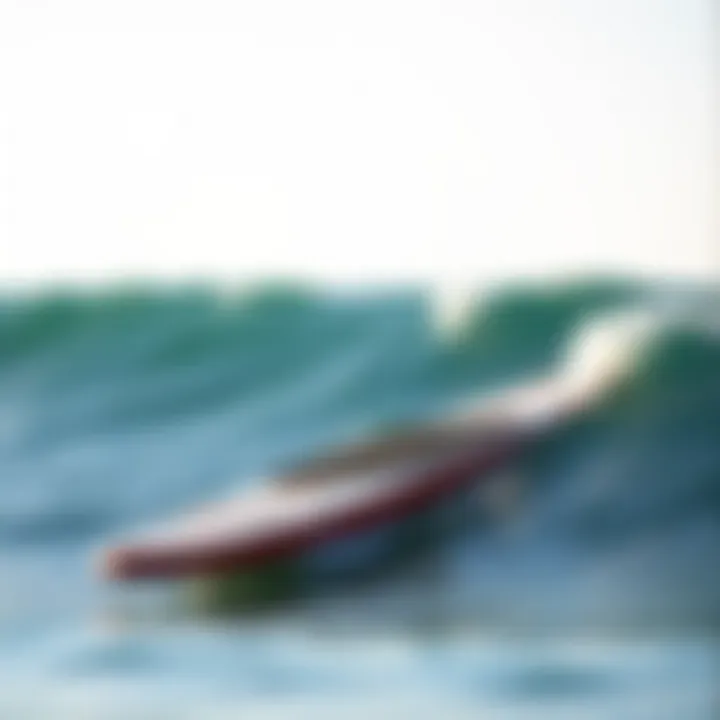
Intro
Choosing the right stand-up paddleboard (SUP) is pivotal for beginners venturing into the water sports arena. Often, newcomers feel like a kid in a candy shop with the sheer variety of boards and associated gear available on the market. The excitement can easily turn to confusion. Often, surf shops and online retailers boast a wide array of options, from inflatable to rigid boards, each with specific attributes catering to different needs. In this guide, we’ll trim down the clutter and break down the essentials for selecting a SUP that best suits your unique style and preferences.
Understanding the gear and equipment is the foundation upon which your paddling journey will unfold. Whether you are eyeing calm lakes, rivers, or the bustling ocean surf, knowing the nuances will arm you with the confidence to make a meaningful decision. Not only will we go over the types of boards but also dive into the subtleties like materials and shapes that often get overlooked. A well-informed choice can mean the difference between a smooth sail or a day drenched in frustration.
As we move through the sections, we'll also tackle accessories that can elevate your paddleboarding experience. Nothing like a solid paddle or a well-fitted life jacket to enhance safety and fun. By the end, you will be equipped with knowledge that helps tailor your selection, ensuring you find a board that complements your paddling aspirations.
Let's set the stage and get into the nitty-gritty of SUP boards.
Understanding Stand-Up Paddleboarding
Getting a grip on stand-up paddleboarding (SUP) isn’t just about hopping on a board and gliding over water. It’s essential to understand the nuances of this increasingly popular sport. Knowing how SUP originated, and its growth trajectory can provide valuable context for new paddlers. This knowledge not only enriches one’s experience but also helps in making informed decisions when selecting the right equipment.
The Origins of SUP
The traces of stand-up paddleboarding can be traced back to ancient cultures. Hawaiian surfers were known to stand on their boards while using paddles to navigate surf, mainly for better visibility over the waves. It was a practical solution that morphed into a sport of its own, marrying both surfing and kayaking elements. Today, SUP has evolved to attract a diverse crowd, from leisure seekers to fitness buffs and adventure enthusiasts.
As the sport spread, it garnered a variety of styles and techniques: from racing to yoga on the water. The historical roots of SUP remind us that it’s more than just a recreational activity; it’s a connection to a rich cultural legacy.
The Growing Popularity of SUP
Over the last decade, stand-up paddleboarding has seen an explosion in popularity. Why is that? For one, it offers a unique blend of exercise and relaxation, making it appealing to a broad audience. You don’t need to be a surfer to enjoy it, nor do you need serious athletic prowess. Folks of all ages can take part—many enjoy leisurely paddles on calm lakes or estuaries, and some even partake in competitive races.
The rise of social media has also played a role in the sport's growth. Pictures and videos showcasing beautiful sunsets and serene waters with paddlers gliding effortlessly have intrigued many. Furthermore, various local communities have sprung up, offering classes and rental services that make it easy for newcomers to give it a try.
In essence, whether it’s about enjoying nature, getting fit, or socializing with others, stand-up paddleboarding offers a little something for everyone, creating a welcoming environment for beginners.
"SUP is more than a sport; it's a lifestyle that encourages adventure and community engagement."
In coming sections, we will delve deeper into how to select the right SUP board, acknowledging historical significance alongside its current appeal, providing you with the necessary tools to make a great choice as you embark on your paddleboarding journey.
Defining Your SUP Goals
Defining your goals before you dive headfirst into the world of stand-up paddleboarding is crucial. This process allows you to tailor your SUP selection to meet your specific needs and aspirations. Understanding the type of paddling experience you seek can drastically affect not only your enjoyment but also your comfort and safety on the water.
Setting clear goals serves as a compass, guiding your choices in selecting the right board. For instance, if your primary aim is recreational paddling, you’ll want to look for boards that prioritize stability and ease of use. Conversely, if you aspire to enhance your fitness levels or are drawn to the adrenaline of surfing, you’ll have different requirements that can dramatically influence board shape and material.
Whether you are a social butterfly wanted to enjoy tranquil afternoons at the lake or an adventure-seeking explorer eager for the next challenge, knowing your motivations can enrich your paddleboarding experience. Here’s a closer look at three popular goals beginners often have when starting out:
Recreational Paddling
Recreational paddling is the most common goal for many newcomers, and for good reason. It often involves leisurely outings with family, friends, or simply enjoying some solitude on calm waters. A board suited for recreational paddling typically emphasizes stability and comfort, making it easier to balance while gliding along. Look for features such as wide decks and rounded hulls; these characteristics help beginners feel secure as they learn to navigate.
Some boards even come with additional comfort features like soft traction pads, which provide better grip and reduce fatigue during longer sessions. This category provides a fantastic springboard into the sport without the overwhelming complexities.
Fitness and Surfing
On the flip side, if your interests are rooted in fitness or surfing, the approach to selecting a SUP board changes significantly. Paddleboarding provides a stellar workout, engaging your core, arms, and legs. Here, agility, maneuverability, and speed take precedence. You might gravitate towards a narrower board that allows for swift strokes and quick turns.
Surfing SUPs are typically shorter and have a more pronounced nose rocker, making it easier to catch waves. These boards are often built with more responsive materials, designed to handle dynamic conditions, ensuring you don’t wipe out when the waves decide to throw you a curveball.
Adventure and Exploration
Lastly, your journey might lead you toward adventure and exploration, where the thrill of venturing into undiscovered waters takes the priority. Boards designed for this type of paddling are often tailored for long distances. They are usually longer and have a pointed nose for better glide efficiency. If you plan to explore rivers, lakes, or even coastal regions, it’s important to prioritize durability and storage options on your board.
Boards with bungee systems upfront for securing gear can be quite beneficial, allowing you to pack snacks or even an overnight bag for extended trips.
Types of SUP Boards
When it comes to stand-up paddleboarding, choosing the right type of board is critical to ensure you have a smile plastered on your face instead of a frown over a bad experience. Each type of SUP board is tailored for specific activities or styles of paddling, and knowing which one aligns with your intended use can greatly enhance your time out on the water.
Here, we break down the major types of SUP boards that often make waves in the market, delving into their features, benefits, and any considerations you might have to keep in mind before making your pick.
All-Around Boards
All-around boards are like the Swiss Army knife of the SUP world. As their name suggests, they are versatile and suitable for various activities, making them a favorite among beginners. These boards typically boast a balanced shape, offering stability while allowing for a bit of fun. Their wider design provides ample buoyancy, which is great for those still finding their sea legs.
- Benefits of All-Around Boards:
- Multi-Use: Great for casual paddling, yoga, and even a bit of surfing.
- Stability: Ideal for beginners who want to avoid the wobbles.
- Ease of Transport: Generally lightweight and can fit in various storage solutions.
Touring Boards
If you’re the kind who revels in long paddles exploring lakes, rivers, or coastal bays, touring boards could be your best mate. These boards are longer and narrower than all-around types, designed to glide efficiently over longer distances, making them suitable for adventure seekers keen on miles over minutes.
- Key Considerations:
- Length: Designed for speed, these boards can be harder to balance on for newcomers.
- Cargo Capacity: Often built to carry gear for longer outings, they usually come with tie-downs for storage.
Fishing Boards
For the anglers among us, fishing boards are specialized in accommodating all the fishing gear you’d want in a day out at sea. These boards typically come equipped with features like anchor points, rod holders, and a wider base for added stability.
- Why Opt for Fishing Boards:
- Stability for Casting: Extra stability is helpful when casting lines or reeling in your catch.
- Storage: Ample space for fishing tackle, coolers, or any essentials your day requires.
Surfing Boards
Surfing boards are made to ride waves. They are shorter, lighter, and have a design that enhances maneuverability, letting you catch waves with style. However, they might not be the best choice for beginners unless you're already comfortable with balancing.
- Characteristics of Surfing Boards:
- Narrow Nose: Helps in slicing through water and catching smaller waves.
- Rocker Profile: Enhances performance in waves but can be tricky to balance on flat water.
Yoga Boards


Finally, if your aim is zen on the water, then yoga boards cater specifically to that. These boards are usually wider and more stable, providing a solid platform for poses, stretching, or even meditation.
- Features of Yoga Boards:
- Extra Stability: Designed for stability which aids balance in various yoga poses.
- Soft Decks: Often feature a cushioned surface that is gentle on the skin during practice.
Choosing the right type of SUP board is not only about functionality but also about ensuring that your experience on the water is enjoyable and aligned with your paddling goals.
Understanding the different types of SUP boards is paramount as each serves a fulfilling purpose catering to various activities and levels of experience. Armed with this information, you can steer confidently towards selecting the SUP that best fits your paddleboarding journey.
Choosing the Right Dimensions
Selecting the right dimensions for your stand-up paddleboard is crucial for beginners. The dimensions define how the board will handle the water, balance, and perform according to your paddling style. Every element of the board’s size has a significant role, affecting not just your stability but also your enjoyment and efficiency on the water.
The ideal choice will depend on a variety of factors like your weight, skill level, and paddling goals. This tailored approach ensures that the board fits not just your physical size but also how you plan to use it. Getting dimensions right could mean the difference between a delightful experience or a frustrating battle against balance and handling.
Length Considerations
When it comes to SUP boards, length plays a pivotal role in determining performance. Longer boards, generally around 12 to 14 feet, are typically faster and glide nicely through the water. They are excellent for touring or long-distance paddling. In contrast, shorter boards, usually from 9 to 11 feet long, are usually more maneuverable, making them a good pick for surfing or navigating in tighter spaces.
You might find that your height and weight will influence which length feels right. Heavier paddlers might benefit from longer boards to improve stability, while lighter paddlers might find shorter boards more manageable. Keep in mind that longer boards can be a bit tricky to turn quickly. So if you aim for tricks or surfing, opting for a shorter length could suit you better.
Width and Stability
The board's width is another factor that can't be overlooked. Wider boards tend to provide more stability, making them ideal for beginners. A width of around 30 inches is very popular, offering an excellent balance between stability and speed. If you’re looking for a sup for yoga or leisurely paddling, a wider board can ensure comfort and ease of use. If you picture yourself racing or touring, you might want to consider narrower options that glide better through the water.
Choosing the right width is especially important for those who may find balance a bit challenging at the start. A wider board can act as a comforting cradle, helping to build confidence while you improve your skills. Remember, stability is key when you're out on the water for the first time!
Thickness and Volume
Thickness and volume go hand-in-hand and are crucial in determining how buoyant your board will be. Generally, the thicker the board, the more volume it has, which adds to its buoyancy. Beginners often benefit from boards that are at least 4 to 6 inches thick. This additional thickness can absorb some of the motion from the waves while also supporting heavier paddlers without sinking too deeply.
Volume also matters because it affects the weight capacity of the board. If you’re planning to bring gear along, or if you simply have a heavier build, a higher volume board becomes essential in ensuring you stay above water. Pay attention to both your own weight and any gear you might bring while choosing your board.
"Choosing the right dimensions provides a sound foundation for an enjoyable paddleboarding experience. Every detail matters, so take your time in finding the right fit for your journey."
Before making a purchase, it's important to consider how these dimensions work together. Each aspect of length, width, and thickness contributes to the overall feel of your paddleboard. Ultimately, the right dimensions will align with your paddling goals and improve your time out on the water.
Materials and Construction
When navigating the waters of stand-up paddleboarding, the materials and construction of your SUP board play a significant role in both your experience and your board's longevity. Understanding these elements is crucial for beginners, as it can greatly influence stability, performance, and even how easily you can transport and store your board. Choosing wisely in this area may mean the difference between a frustrating outing and a joyous paddle.
Inflatable vs. Rigid Boards
In the world of SUP boards, the debate between inflatable and rigid (hard) boards is like two sides of the same coin, each offering unique advantages. Inflatable boards are made from a durable PVC material and packed with air, making them lighter and easier to transport. They can be deflated and rolled up, which is a boon for those with limited space or who wish to travel.
On the other hand, rigid boards are generally considered superior in performance. Their solid construction allows for better speed and maneuverability, which works well for surfers and those looking for a more serious paddling experience. They do take up more space and require a bit more muscle to transport but can provide that steady ride many experienced paddlers crave.
Here’s a quick comparison:
- Inflatable Boards:
- Rigid Boards:
- Pros: Lightweight, portable, stable for beginners.
- Cons: May lack speed and maneuverability, can be susceptible to punctures.
- Pros: Superior performance, better speed, and maneuverability.
- Cons: Heavier, harder to transport, more vulnerable to damage.
Common Materials Used
Stand-up paddleboards come in a variety of materials, each contributing to the board's weight, durability, and overall feel on the water. For inflatable boards, the most common material is drop-stitch fabric, which is layered and bonded to create a strong, rigid structure when inflated. It’s what gives inflatable boards impressive rigidity when in use, despite being flat when stored.
Rigid boards, in contrast, often utilize materials like epoxy, fiberglass, or plastic. Epoxy boards are known for their lightweight and strong nature, making them ideal for maneuvering through waves. Fiberglass models combine agility with durability but can be prone to scratches and dings. Plastic boards, while often more affordable, tend to be heavier and may not provide the same performance level as their epoxy or fiberglass counterparts.
Impact on Performance
The material and construction of your SUP board have a direct impact on its performance in the water. For instance, boards made of lightweight materials such as epoxy are often quicker and more responsive, giving you the edge if you're planning on racing or surfing. Conversely, heavy boards may feel more stable due to their weight but can overly bog down paddlers looking for efficiency.
Moreover, the way a board is constructed can also affect its flexibility. A board with high rigidity can translate to better energy transfer during paddling, allowing for more effective strokes and improved speed. Similarly, a buoyant, well-constructed inflatable may slice through calmer waters seamlessly, catering perfectly to leisure paddlers.
"The right materials can transform a paddleboard from just a piece of gear into a trusted companion on countless adventures."
Resources for Further Reading
Through careful consideration of materials and construction, you enable yourself to make an informed decision that aligns with your paddling ambitions.
Essential Accessories for Beginners
When starting out in stand-up paddleboarding, it’s not just the board that counts; accessories play a crucial role in ensuring that your experience is safe and enjoyable. Paraphrasing the old saying, it's not just the bike but the helmet that keeps you rolling smoothly! A beginner without the right accessories might feel a bit like a fish out of water, so understanding what you need can make or break your initiation into this rewarding sport.
Paddles
The paddle is, without a doubt, your main tool when it comes to navigating the waters. Choosing one can be a bit daunting given the variety of options available. Typically, paddles come in different materials like aluminum, fiberglass, and carbon fiber, each offering varying weight and flexibility. Aluminum paddles are often budget-friendly and sturdy, making them a good option for those just starting out. However, if you're looking for something lighter and more efficient, investing in a fiberglass paddle may be the way to go.
- Length: Ensure the paddle is the right length for your height and style of paddling. A general rule of thumb is to hold the paddle vertically with the blade on the ground; the handle should reach just above your head.
- Weight: The lighter the paddle, the easier it is to maneuver, especially over longer distances.
Leashes
A leash might seem like a small detail, but it’s your lifeline on the water. Think about it—if you take a spill, would you want to chase after your board, or have it come back to you? A leash keeps the board connected to you, providing that necessary safety net. There are different types of leashes such as ankle leashes and calf leashes, the choice often depending on personal preference and paddling style.
- Ankle Leashes: These are the most common and are great for casual paddling.
- Calf Leashes: Ideal for surf conditions, keeping the board closer in the waves.
Investing in a high-quality leash is essential. It's a small price for peace of mind, ensuring that you remain safe in case of falls or unexpected conditions.
Life Jackets and Safety Gear
Safety cannot be overstated when venturing into any water activity. A life jacket or personal flotation device (PFD) is a must-have. In certain areas, wearing a life jacket is not just a wise choice—it’s actually the law. A properly fitted life jacket ensures not only your safety but also your comfort while paddling. Lightweight, breathable options are available that won’t impede your movements. Also consider carrying a whistle and a basic first aid kit, just in case you encounter trouble.
- Comfort and Fit: Look for a PFD that allows for freedom of movement.
- Visibility: Bright colors improve visibility, especially in busy waterways.
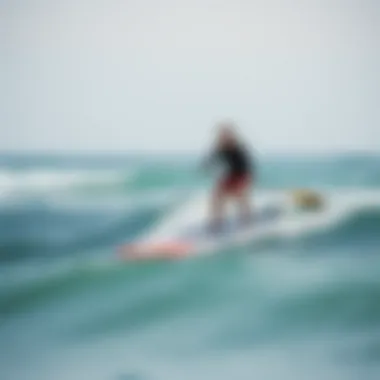
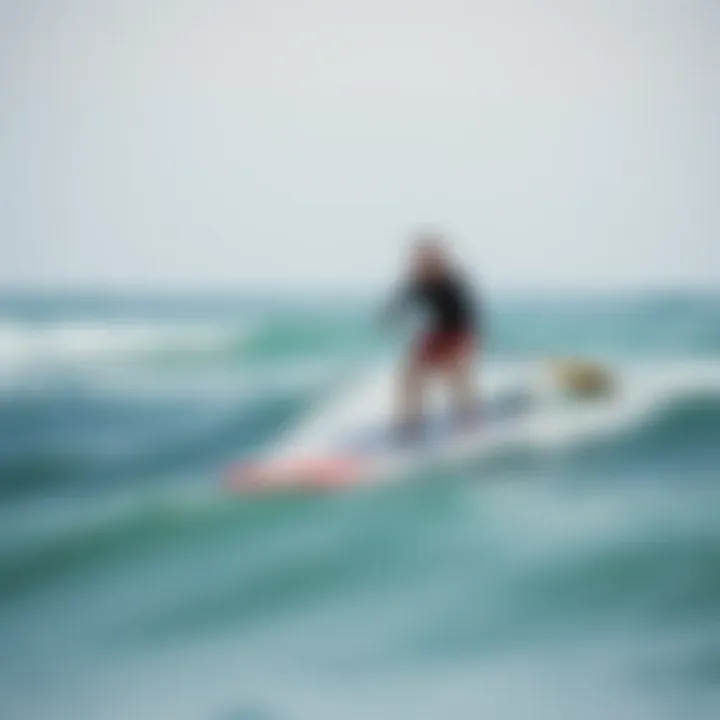
Remember, a few layers of protection can go a long way in keeping adventures enjoyable and safe.
Board Bags and Storage Solutions
Once you’ve got the perfect board, you want to keep it in good shape. A board bag is essential for protecting your SUP during transport and storage, particularly if you’re going to be loading it on top of your car or stowing it away for long periods.
When searching for a board bag, you’ll find options that are padded for maximum protection as well as lighter versions that suffice for local trips. Moreover, proper storage solutions ensure your board remains intact and ready for your next outing instead of collecting dust in the garage.
- Padded Bags: These provide cushion against impacts and scratches.
- Dry Bags: A great addition for storing spare clothes and food to keep them dry during adventures.
Overall, a good board bag can extend the lifespan of your SUP, allowing you to focus on having fun on the water instead of worrying about damage.
The right accessories can transform your stand-up paddleboarding experience, making it safer, more enjoyable, and stress-free.
Understanding Stability and Performance
Selecting the right stand-up paddleboard (SUP) goes beyond simple design aesthetics or price tags. Truly understanding the stability and performance of a board can make or break a beginner's experience. For someone just dipping their toes—figuratively and literally��—into the world of paddleboarding, a solid grasp of these concepts is invaluable. More than just buzzwords, stability and performance translate into comfort on the water and overall enjoyment of the sport.
Wide Boards vs. Narrow Boards
When deciding on a paddleboard, one of the primary factors that comes into play is the width of the board. Wider boards generally offer enhanced stability. This is particularly advantageous for newcomers who may not yet have their balance dialed in. A wide board acts like a sturdy platform, making it less likely to tip over, which can boost confidence immensely.
On the flip side, narrow boards might appeal to those who value speed and agility. They typically glide more efficiently through the water. However, they also require a steady hand and a keen sense of balance, which can be a tall order for beginners still mastering their footing.
- Pros of Wide Boards:
- Cons of Wide Boards:
- Greater stability even in choppy waters
- More space for activities like yoga or fishing
- Easier for beginners to find their footing
- Can be slower when it comes to paddling efficiency
- Might feel cumbersome for more advanced techniques
For beginners, a width of 30 inches is often a sweet spot. It gives just enough stability while opening the door to agility as skills develop.
Rocker Profile
Rocker profile, or how much the board curves upward towards the nose and tail, is another critical element to consider.
- Flat Rocker: A board with a flat rocker is generally more stable and offers better paddling efficiency. This is ideal for long-distance trips or leisurely rides on calm waters.
- Moderate Rocker: A moderate rocker provides a balanced experience, suitable for both flat waters and mild waves, giving versatility for those who want a taste of adventuring in different conditions.
- Aggressive Rocker: Lastly, boards with an aggressive rocker are designed for performance in waves, allowing quick maneuvering and responsiveness. However, they might not be the best choice for someone still learning to balance.
Ultimately, the right rocker profile for a beginner should favor stability and ease of use, over performance-oriented designs.
"Prioritizing stability and understanding board dynamics lays the groundwork for a safe and enjoyable paddleboarding experience, fostering not just skills but passion for the water."
By paying attention to these key aspects of stability and performance, newcomers can greatly increase their first-time paddleboarding experiences. It's all about finding that right balance—pun intended—between comfort and adventure. As they gain confidence and perhaps venture into new waters, they'll find that understanding these elements will lead to more exhilarating and enjoyable paddling adventures.
Testing Before Purchase
When it comes to selecting the right SUP board, testing before rolling out any cash is crucial. For those just dipping their toes in the paddleboarding waters, it might be tempting to pull the trigger on a purchase after a quick online search or a couple of reviews. Yet, nothing beats the feel of a board beneath your feet. Testing can save you from the hassle of buyer's remorse and ensure you’re truly compatible with your choice.
Engaging in demo days or rentals is a golden opportunity to experience various boards first-hand. Not only do you get to see how a board handles in the water, but you also gain valuable insights about what you personally prefer. Understanding how a board feels in motion and how it responds to your paddling style can make a world of difference in your paddleboarding adventures. These experiences can provide a solid baseline for your expectations when it comes to comfort and control.
Always remember: the right board can elevate your experience, while the wrong choice can leave you feeling frustrated and overwhelmed.
Demo Days and Rentals
Demo days are often organized by local shops or paddleboarding communities, and they provide a fantastic platform for beginners to try multiple boards side by side—all in one place. This can be quite the revelation. Imagine standing on a board that seems a bit too wobbly for comfort, only to hop onto one that feels like it’s glued to the water. This is the kind of immediate feedback you can get.
Rentals also offer another layer of testing. They allow you to take a board out on your own terms and under various conditions. You might find that a board you thought would be perfect for flat lake paddling doesn’t hold up as well in choppier ocean waves. Here’s why rentals are worth considering:
- Variety: Multiple board styles to test.
- Affordability: Lower cost than purchases.
- Familiarity: Get comfortable with the basics without the commitment.
Spending a little time testing different boards can make the decision-making process much more manageable. After all, you don’t want to invest in a board and then realize it’s not quite your cup of tea.
Assessing Comfort and Control
Once you're on the water, it's critical to evaluate how the SUP board feels under your feet. Comfort isn’t just about how squishy the grip is or the aesthetics of the board. It's about how securely you feel as you paddle forward. A board that provides solid stability while also allowing for responsive movement can make for a much smoother outing.
Here are a few things to look out for while assessing comfort and control:
- Balance: Can you maintain your stance with ease? If you’re constantly wobbling, it’s likely the board isn't for you.
- Paddle Positioning: How do you feel when you reach out with your paddle? Is the board silent and smooth, or does it feel like you’re pushing against solid resistance?
- Turning and Maneuverability: How easily can you change direction? A board that takes a good deal of effort to turn may not be ideal, especially if adventure and exploration are on your agenda.
Your connection to the board is key. When in control, you can focus on the experience—not just on staying upright. Spend that time testing, and trust your instincts. The right board feels right from the start, and when you find that fit, you’ll know you've hit the jackpot.
Caring for Your SUP Board
Taking the time to care for your stand-up paddleboard (SUP) isn’t just a good idea; it’s downright essential. A well-maintained board can make a world of difference, extending its lifespan and ensuring optimal performance. Whether you're gliding across flat waters or tackling choppy waves, knowing the ins and outs of SUP maintenance will keep your board in prime condition and ready for your next adventure.
There are a few key points to keep in mind when caring for your SUP: maintenance routines, proper storage, and understanding how to protect your investment against the elements. Regular attention to these factors not only enhances your overall paddling experience but also bolsters safety while you're out on the water.
Regular Maintenance Tips
Routine maintenance can go a long way in preserving your SUP. Here are several handy tips to consider:
- Rinse After Use: Make it a habit to rinse your board with fresh water after each use, especially if you’ve been paddling in saltwater. This removes any sand and salt that could cause damage over time.
- Inspect for Damage: A quick visual check can help spot hairline cracks or dings that may worsen if left unattended. This can save you from costly repairs down the line.
- Keep it Clean: Use a mild soap and a soft cloth to clean your board regularly. Avoid harsh chemicals as they may harm the surface material.
- Check the Fins: Ensure your fins are securely attached and free of debris. Loose fins can affect your control and overall performance on the water.
"Regular maintenance isn't just a chore; it's a way to keep the adventure alive for your paddleboard."
Maintaining your SUP is about setting a routine that keeps the fun rolling while ensuring you're well-prepared for your outings.
Storage Solutions
Where you store your SUP can greatly affect its longevity. Taking care of your board doesn't end after a session; how you store it can protect it from UV damage, temperature changes, and physical harm.
- Indoor Storage: Whenever possible, store your board indoors in a temperature-controlled environment. This can prevent warping or other damage from extreme temperatures.
- Use a Board Bag: Consider investing in a padded board bag. Not only does this provide protection during transport, but it also shields your board from dust and minor impacts while stored.
- Avoid Direct Sunlight: If you must store your board outside, try to keep it under a shade or cover to avoid sun damage. UV rays can fade the color and weaken the materials over time.
- Horizontal or Vertical Storage: If you’re short on space, boards can be stored vertically but ensure it’s secured so it won’t fall. Horizontal storage on a rack, however, is often recommended as it evenly distributes weight and minimizes pressure points.
With thoughtful care and smart storage techniques, you can ensure your SUP remains a reliable companion for years to come.
Navigating Local Regulations
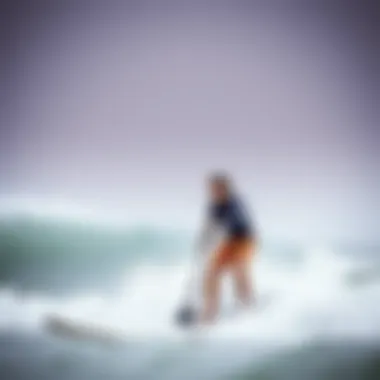
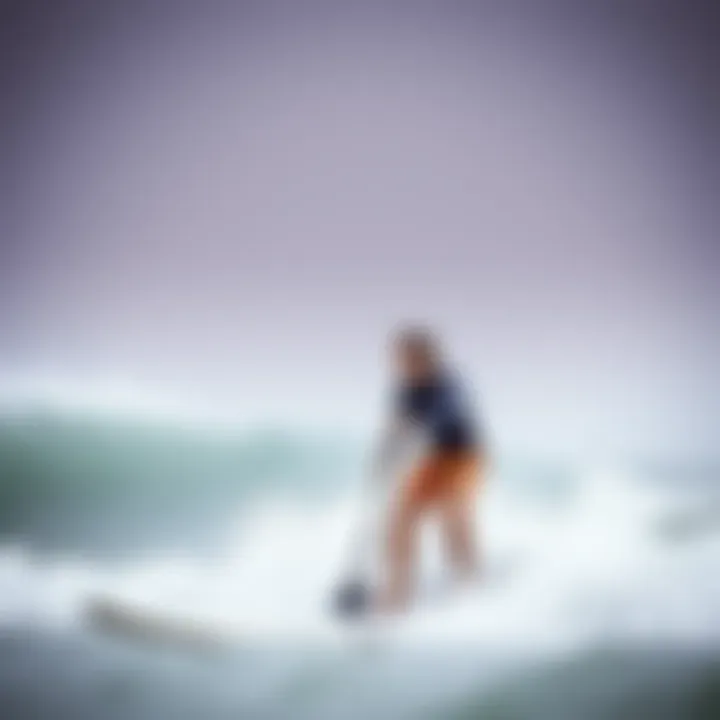
When setting out on your stand-up paddleboarding (SUP) journey, understanding local regulations is crucial. Every body of water has its own set of rules that can impact your experience and safety. Not knowing the guidelines can lead to unwanted fines or, worse, unsafe situations on the water. This section shines a light on what you need to be aware of regarding waterway regulations, permits, and licenses to ensure a smooth paddle for beginners.
Understanding Waterway Rules
Each waterway — be it a lake, river, or ocean — has specific rules to follow. These can cover everything from speed limits to restricted zones.
- Designated Areas: Some spots are designated solely for non-motorized paddling. Familiarizing yourself with these areas ensures you can enjoy the surroundings without conflict.
- Safety Equipment: Depending on local law, you might be required to have certain safety gear onboard. This could include life jackets, whistles, and signaling devices, among others.
- Respect for Wildlife: Many waterways are home to various species. It's vital to respect wildlife restrictions, especially in protected areas. Observing a no-wake zone can be just as crucial to sustaining the local ecosystem as paddling smoothly.
- Local Fisheries: If you're fishing from your SUP, you might need a fishing license. Each state or region has its own regulations regarding fishing and paddleboarding, so it’s smart to check local guidelines.
Getting acquainted with these rules can turn a potentially stressful outing into a relaxed day on the water. Knowledge of regulations enables you to paddle confidently, knowing you’re following the rules of the roador in this case, the water.
Permits and Licenses
Diving into the world of permits and licenses might feel overwhelming, but there’s no reason to fret. Here’s a breakdown of what you need to know:
- When You Need a Permit: Some waterways require a permit for recreational activities like paddleboarding. Depending on the location, obtaining a permit can be as easy as filling out an online form or picking it up at a local ranger station.
- State-Specific Rules: Laws vary from state to state. For instance, California has specific regulations for SUPs, while others have more relaxed rules. Make sure to check your state’s Department of Natural Resources website for official information.
- License for Fishing: If fishing is on the agenda, a fishing license isn’t just a good idea; it’s often a legal requirement. Ignoring this can lead to hefty fines, so it’s worth looking up your local fishing regulations.
Engagement with local authorities can provide clarity on what you need to enjoy paddleboarding while staying within legal limits. Remember, complying with these regulations not only keeps you safe but also fosters a sense of community among fellow paddlers.
"Paddle smart, stay safe, and you'll find that the waters are a welcoming place for everyone."
Thus, navigating local regulations is not just about compliance; it's about respect. When everyone abides by the rules, the experience becomes enriching for everybody. Building a foundation of knowledge about these regulations can enhance your enjoyment on the water and contribute to a more sustainable environment for future paddlers.
Connecting with the Community
For any novice paddler, getting into stand-up paddleboarding is often more than just choosing the right board—it's about finding a sense of belonging. Connecting with the community is crucial. It can enhance your journey by providing insights, support, and camaraderie. Here’s why it matters:
- Shared Knowledge: Being part of a community allows you to tap into a wealth of shared experiences and tips. Whether you’re learning to balance on the board or exploring the best local spots, seasoned paddlers can offer invaluable advice.
- Increased Motivation: Surrounding yourself with fellow enthusiasts can fuel your passion. Seeing others tackle challenges can encourage you to step up your game or even try new techniques or styles.
- Safety in Numbers: Paddling together not only makes the experience more enjoyable, but it can also enhance safety. Having friends along means help is readily available if any unexpected bumps arise on your adventure.
- Events and Opportunities: Many communities organize paddle outings, races, and even social gatherings that can deepen your connection to this sport and introduce you to new friends. By getting involved, you’ll be in the loop about upcoming events and competitions that you might want to participate in.
With all these benefits, you’ll likely be eager to dive into the next aspects of community engagement.
Finding Local Groups and Clubs
Local groups and clubs can be pivotal in helping beginners find their footing in the paddleboarding waters. Many clubs offer structured activities that cater to various skill levels. You can join group paddles, instructional classes, or even workshops focusing on specific techniques or safety courses.
- Where to Look: You can start with platforms like Facebook or Meetup to search for local paddling clubs. Don’t overlook community centers or outdoor shops that often host events or can point you to groups in your area.
- Benefits of Joining: Membership in a club can come with perks like discounts on gear, exclusive access to events, or advice from experienced paddlers that you wouldn’t easily find online.
Participating in Events and Competitions
Engaging in local events or competitions can greatly enhance your experience. Even if you’re just starting out, participating in these gatherings helps you to challenge yourself, learn new skills, and meet others passionate about paddleboarding.
- Types of Events: Look out for local races, friendly competitions, and fun paddle outings. Many areas even host social events that cater to all levels, such as community clean-ups combined with paddle adventures.
- Building Skills: Events often feature clinics or workshops led by more experienced paddlers. These sessions can help you refine your technique, boost confidence in your skills, and offer new perspectives on paddling.
- Networking: Competitions are a great way to network with other enthusiasts and industry professionals. This can lead to opportunities for sponsorships, collaborations, or simply friendships that might last a lifetime.
Participating in paddleboarding events allows you to step outside your comfort zone and discover the joy of community.
For anyone looking to grow in paddleboarding, considering the community aspect should be a top priority. It’s an investment into both your sport and your social life.
Making Your Choice
Choosing the right stand-up paddleboard (SUP) is more than just picking a pretty color or a catchy brand name. It’s a decision that can greatly impact your overall experience on the water. When you're a beginner, it might feel like you're standing at the base of a mountain looking up — overwhelmed by choices yet eager to begin your journey. Understanding the importance of making the right choice is crucial; it reflects on your stability, ease of use, and even your enjoyment as you navigate the waters.
Final Considerations in Selecting a Board
Before pulling the trigger on your first board, consider the elements that will shape your paddling adventure. Here are some key points to reflect upon:
- Intended Use: What do you aim to do with your SUP? Whether it's leisurely paddling on calm lakes, riding the gentle waves at the beach, or perhaps going for long-distance touring, your activity choice will guide your board selection.
- Board Type: Each board type from all-around to racing models serves a specific purpose. Familiarize yourself with their characteristics to match your paddling goals.
- Budget Constraints: A dollar spent today might save you a headache tomorrow. Setting a realistic budget is essential. This doesn't mean you should skimp on quality; however, knowing the price range you’re comfortable with can streamline the process.
- Weight Capacity: Not all boards can support the same weight. Depending on your size and the gear you'll carry, make sure the board's capacity meets your needs.
- Storage and Transportation: Consider how you will transport your SUP. If you're limited on space, it might be worth leaning towards an inflatable option, as these are easier to store and transport.
- Community Insight: Connect with your local paddleboarding community or forums. Reading reviews on platforms like reddit.com can provide insights that you might not find in standard product descriptions. Often, fellow beginners and seasoned paddlers share their experiences, helping you formulate a clearer picture of what to expect.
"The only mistake you can make is not making a choice. Every board teaches you something, whether it’s what to look for next time or simply what you enjoy most!"
Once you’ve mulled over these aspects, it’s all about personal preference. Your selection should resonate with your ambitions and feelings about what you want to get from paddleboarding. Whether it's leisurely waves or scenic tours, the right board can elevate your experience immensely.
Budgeting for Your First Board
Selecting the right stand-up paddleboard (SUP) is not just about the board itself, it also involves making sure that the financial aspect aligns with your overall experience. Setting a budget for your first board is crucial, as it influences your options significantly. Whether you’re looking to float on calm lakes or you’re eyeing the waves, understanding the costs can make the difference between a smooth ride and a regretful purchase. By putting thought into budgeting, you can prioritize quality, look ahead for necessary accessories, and maximize your enjoyment without breaking the bank.
When you think about the money you’re willing to spend, remember that your initial investment can pay off in the long run. A well-chosen board not only helps you enjoy the sport more but can also enhance your skill development.
Setting a Realistic Budget
Before diving headfirst into the SUP world, take a moment to assess your financial prospects. Ask yourself: How much are you comfortable spending on your first board? Typically, entry-level boards can range from $300 to $800. However, depending on your needs, you may need to adjust that ballpark.
- Research Prices: Take the time to browse various retailers online and offline, checking out brands like Red Paddle Co. or BIC Sports. This gives you a solid idea of what to expect.
- Consider Additional Costs: Don’t forget about accessories such as paddles, leashes, and safety gear. You might be tempted to grab the board and go, but it's wise to include at least another $200-$300 in your planning to cover these essentials.
- Quality vs. Price: A lower-priced board may be enticing, but often they lack the durability or performance features that make paddling enjoyable. Allocate funds wisely to ensure you're not just shopping for the cheapest option.
Ultimately, a budget shouldn’t just be a matter of pennies and dimes; rather, it’s a strategy for ensuring you enjoy your time on the water.
Identifying Value for Money
Value for money isn’t always about the cheapest option. It’s finding the right balance between quality, features, and your intended use. This involves a little more digging, particularly in evaluating what different boards offer at various price points.
- Features to Look For: Boards designed for beginners should have features such as wider bases for stability, which are priced appropriately. Check if the board includes tie-down straps for gear or a comfortable deck pad.
- User Reviews: Don’t take the marketing material at face value. Seek out reviews on platforms like Reddit or dedicated paddleboarding forums—to glean from others' experiences. First-hand accounts can give insight into discomforts or flaws that might not be evident on a glossy website.
- Longevity: Think ahead. A well-built board that holds its shape and integrity can save money in the long run. Spending a little extra now may ensure you can paddle for years without needing to replace it.
"The best investment is not always the one with the lowest price, but the one that brings the best experience."
In summary, budgeting for your first SUP board isn’t merely about number crunching; rather, it’s about aligning your finances with your aspirations on the water. Taking the time to set a realistic budget and identifying the true value of what you want will enhance your enjoyment and proficiency, setting a solid foundation for a rewarding paddling journey.
For further insights and community discussion, check resources like the Paddleboard Community on Facebook or SUP forums on Reddit.
Reviewing the Best Options for Beginners
Selecting the right stand-up paddleboard (SUP) can be a daunting task for beginners. With a plethora of models available, understanding what's best can make or break an individual’s experience on the water. This section is vital as it consolidates all the knowledge gleaned from previous parts of the article, focusing on several specific elements that will aid in making an informed decision.
When it comes to choosing an SUP, several factors come into play, such as stability, durability, comfort, and ease of use. A board that caters to these specifics not only enhances performance but also boosts confidence for those new to the sport. Additionally, the right choice minimizes the chances of frustration or disappointment—nobody likes floundering in the water, especially during their first outing!
A wise approach is to consider what you want from your paddleboarding experience. Are you looking to leisurely glide on calm lakes, tackle ocean waves, or perhaps engage in fitness routines? The defined purpose can dramatically narrow down the options and clarify key features to look for in a board.
Another critical point to consider is customer reviews. Many people share their experiences online. Platforms such as Reddit and Facebook often showcase real-life feedback that can be more insightful than manufacturers’ claims. This kind of information helps beginners weigh up pros and cons, making the selection process smoother. Additionally, local shops can provide demo boards, allowing potential buyers to physically test models before making a commitment. This hands-on experience can reveal much about comfort and suitability.
In summary, reviewing the best options is essential for beginners not just for comfort's sake, but it also leads to a more enjoyable paddleboarding adventure. With well-informed choices, could be a sweet escape into aquatic leisure rather than a morning spent struggling against the elements.
Top Models Available in the Market
When it comes to options on the market, several models stand out due to their balance of performance and beginner-friendly features. Here’s a rundown of some top picks:
- Red Paddle Co. Ride 10'6"
Known for its durability and stability, this inflatable model is perfect for beginners who value versatility. It’s easy to transport and store. - ISLE Versa 10'
A popular all-around board that is lightweight and constructed with high-quality materials. Its wide design enhances stability, making it a solid choice for newcomers. - Aqua Spirit 11'
This board offers a great price-to-performance ratio, making it an excellent entry-point for those wanting to explore paddleboarding without breaking the bank. - BIC Sport ACE-TEC 11'
Its unique construction ensures reliability and performance on various water types, making it favored among many beginners who appreciate multipurpose paddleboarding. - Tower Adventurer 9'10"
This board is excellent for fitness aficionados, as its streamlined shape aids in swift paddling.
These options reflect a range of styles, catering to different preferences and needs. As it often happens in life, you get what you pay for—investing in a quality board can provide a much more fulfilling paddleboarding experience. For those still wondering, many local retailers have great supply or online reviews that delve deeper into these models. Conditions can vary greatly, so what works well in one setting might not in another—keep that in mind when making your choice!







